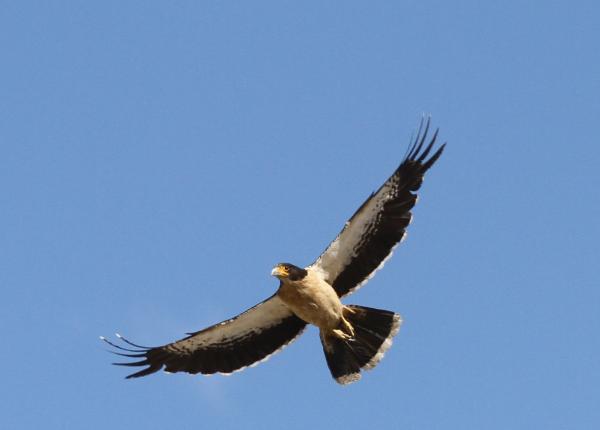How The Peregrine Fund is Helping
Though The Peregrine Fund does not work directly with White-throated Caracaras, our efforts in scientific research, habitat conservation, education, and community development help conserve birds of prey around the world. We also supply literature to researchers from our avian research library, which helps scientists around the world gather and share important information on raptor conservation. Our work with the Neotropical Raptor Network helps conserve raptors by fostering collaboration and communication among raptor enthusiasts in the region. And, finally, our support of the Global Raptor Information Network gives raptor researchers tools to more efficiently conduct their own studies while contributing to a global program. It also provides citizen scientists a way to participate in raptor science and conservation.
Where They Live
The White-throated Caracara is a Neotropical raptor found in Chile and Argentina. It prefers living in montane areas, and at sea level in the southern parts of range. It lives in open habitat and is often seen perched on high cliffs, hillsides, or fences.
What They Do
As its name implies, the White-throated Caracara has a white throat! It also has a white breast and white tip on its tail, as well as white underwing-coverts, which you can see clearly in the photo above. All of this white contrasts beautifully with this bird's black back and wings. It has a reddish facial skin and a pale grayish bill. This stunning falcon spends a lot of its time flying slowly and gliding at great heights. According to researchers, this species is shy and very wary of people.
Why They Need our Help
The White-throated Caracara is categorized as a species of Least Concern. Thankfully, its habitats aren't being destroyed and people don't persecute this species, so this species isn't in peril in the immediate future.
What They Eat
While there is still so much to learn about the diet of the White-throated Caracara, we do know that it feeds on carrion (animals that are already dead) and it also spends time foraging for food at garbage dumps and sheep-slaughtering sites. In Torres del Paine National Park in Patagonian Chile, it feeds mostly on cattle carcasses, but also preys on small rodents and insects. In fact, it finds many of the insects it feeds on by turning over cow piles (poop) to search for them.
Nests, Eggs, and Young
Little is known about the breeding habits of this caracara. We do know it builds its nest on rocky cliffs, and that the female lays between 2-3 eggs.
White-throated Caracara and the World Center for Birds of Prey
The World Center for Birds of Prey offers fun ways to learn about birds of prey. The visitor center offers interactive displays, tours, interesting videos and a children's room with activities from coloring sheets to quizzes to costumes and a touch table for the curious mind. We also have several different birds of prey on display year-around. Knowledgeable staff and volunteers are on hand to answer any questions you may have about White-throated Caracaras or any other birds of prey.
References:
Bierregaard, R. O. and G. M. Kirwan (2020). White-throated Caracara (Phalcoboenus albogularis), version 1.0. In Birds of the World (J. del Hoyo, A. Elliott, J. Sargatal, D. A. Christie, and E. de Juana, Editors). Cornell Lab of Ornithology, Ithaca, NY, USA. https://doi.org/10.2173/bow.whtcar1.01
Global Raptor Information Network. 2021. Species account: White-throated Caracara Phalcoboenus albogularis. Downloaded from http://www.globalraptors.org on 31 Dec. 2021









